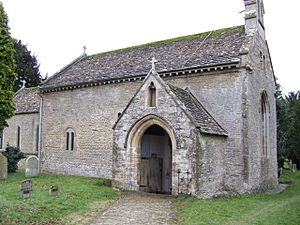St Peter's Church, Southrop facts for kids
Quick facts for kids St Peter's, Southrop |
|
|---|---|

St Peter's Church from the north
|
|
| Lua error in Module:Location_map at line 420: attempt to index field 'wikibase' (a nil value). | |
| OS grid reference | SP 20209 03420 |
| Location | Southrop, Gloucestershire |
| Country | England |
| Denomination | Anglican |
| History | |
| Status | Parish church |
| Architecture | |
| Functional status | Active |
| Heritage designation | Grade I |
| Administration | |
| Deanery | Fairford |
| Archdeaconry | Cheltenham |
| Diocese | Gloucester |
| Province | Canterbury |
St Peter's Church is an Anglican church located in Southrop, a small village in the beautiful Cotswolds area of Gloucestershire, England. It is a busy parish church that is part of the Diocese of Gloucester. The church is very special because it has been given a "Grade I" listing by English Heritage. This means it is considered a building of exceptional historical importance. The church stands on the site of an even older building and parts of the current church date back to the 12th century.
Contents
History of St Peter's Church
A church has stood on this spot since Anglo-Saxon times, which was many centuries ago. The oldest parts of the church you see today were built in the 12th century.
From 1823 to 1825, a vicar named John Keble worked at St Peter's. During his time there, he made an exciting discovery. He found a round baptismal font that was built in the Norman style, hidden in the church wall. A font is a special basin used for baptisms.
Why St Peter's is a Grade I Listed Building
St Peter's Church was officially named a Grade I listed building by English Heritage on January 16, 1961. This "Grade I" title is the highest of three levels. It is given to buildings that are "of exceptional interest," meaning they are very important, sometimes even worldwide. In 1982, a writer named David Verey described St Peter's as a "most precious" church in his book Cotswold Churches.
St Peter's is still an active parish church today. It belongs to the Church of England and is part of the Diocese of Gloucester.
Famous Wedding at the Church
On July 2, 2011, famous model Kate Moss and guitarist Jamie Hince were married at St Peter's Church.
Architecture of the Church
Outside the Church
St Peter's Church is built from limestone rocks and has a roof made of stone tiles. Some of the stone work on the walls is in a special pattern called "herringbone," which looks like fish bones.
The church's layout includes a main hall called a nave, a smaller section on the south side called a transept, a covered entrance called a porch on the north side, and the chancel at the east end. The north entrance is built in the Norman style and is quite grand for a small church. The round arch of the porch has decorative moulding. The doorway's side posts, called jamb shafts, have carved tops called capitals with spiral shapes called volutes. Above the door, there is a space called a tympanum with a patterned design.
Both the north and south walls of the nave have windows from the 12th century. There are also newer windows from the 19th century. The nave also has a large window with three sections and decorative stone work in the Perpendicular style. The east window in the chancel has beautiful stained glass that was designed in 1852 by Thomas Willement.
Inside the Church
The arch that connects the nave to the chancel is also in the Norman style and is quite plain. In the south wall of the chancel, there are two small basins called piscinae, which were used for washing sacred vessels.
The round baptismal font that Rev. John Keble found in the 1820s is still in the church. It has eight arches and carved figures. These figures include the Virtues, which are shown stepping on the vices (bad habits), and a figure of Moses. Inside the church, you can also see effigies (sculpted figures) of Thomas and Elizabeth Conway, and memorials dedicated to the Keble family.
Churchyard
The churchyard, which is the area around the church, contains war graves. These are the graves of one soldier from World War I and another from World War II.
See also
- Grade I listed buildings in Gloucestershire

